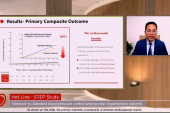Village-Level Intervention Nets Big BP Control Gains in Rural China
“One could assume . . . you’re going to see an enormously large cardiovascular event benefit as well,” Paul Whelton says.

An intervention delivered by village doctors—community health workers with basic medical training—in rural China resulted in a substantial jump in the number of hypertensive patients who had their blood pressure controlled, according to the results of a cluster-randomized trial.
After 18 months, 57% of patients living in intervention villages had BP below 130/80 mm Hg, compared with just 19.9% of those living in control villages (P < 0.001), Jiang He, MD, PhD (Tulane University School of Public Health & Tropical Medicine, New Orleans, LA), reported Saturday at the virtual American Heart Association (AHA) 2021 Scientific Sessions. The average drop in BP over that span was greater by 15/7 mm Hg with the intervention.
“This feasible, effective, and sustainable implementation strategy could be scaled up in rural China and other low-resource settings for hypertension control, with the overall aim of reducing cardiovascular disease and all-cause mortality,” He said at a media briefing.
Though He didn’t report data on clinical outcomes, Paul Whelton, MD (Tulane University School of Public Health & Tropical Medicine), who was not involved in the study, told TCTMD that “one could assume—I think very reasonably—if you get a 15-mm Hg difference in blood pressure, you’re going to see an enormously large cardiovascular event benefit as well.”
Moreover, said Whelton, there are aspects to this approach that could be implemented around the world, including the United States.
The China Rural Hypertension Control Project
Most of the people with hypertension across the world live in low- and middle-income countries, and control rates are low. In China in particular, awareness, treatment, and control of high BP are poor. According to a recent survey, only 5.5% of hypertensive patients living in rural China, in fact, had their BP controlled in 2014, He said.
In the current cluster-randomized trial known as the China Rural Hypertension Control Project, investigators tested whether control rates could be boosted with an intervention delivered by village doctors. These nonphysician community health workers have some medical training and are certified by local authorities in rural parts of the country to deliver basic primary healthcare and public health services.
The study took place in 326 villages across three Chinese provinces. Investigators recruited 33,995 patients who were 40 or older (mean age 63 years; 61% women), had uncontrolled hypertension, and were enrolled in the China New Rural Cooperative Medical Scheme, which covers basic healthcare services for 99% of rural residents—17,407 lived in intervention villages and 16,588 lived in villages where they received usual care.
The intervention involved a stepped-care protocol for hypertension treatment adapted from the US guidelines, with a BP goal of less than 130/80 mm Hg, lower than the goal of less than 140/90 mm Hg recommended in the Chinese guidelines. Under the supervision of primary care doctors and hypertension specialists from nearby hospitals, the village doctors were trained to perform standardized BP measurement, to deliver antihypertensive medications according to the protocol, and to counsel patients on lifestyle modification and medication adherence. Patients, who were followed monthly, received discounted or free medications and home BP monitors.
The median duration of hypertension at baseline was 7 years, with an average BP of roughly 157/88 mm Hg. Patients had uncontrolled BP despite that fact that 58% reported using antihypertensive medications.
The proportion of patients with controlled BP increased over the course of the trial in both groups, although the gains were significantly larger in the intervention arm. The absolute difference in control rate favoring the intervention was 37.0% when the goal was less than 130/80 mm and 32.7% when the goal was less than 140/90 mm Hg.
The results were consistent across subgroups defined by age, sex, education, and antihypertensive medication use at baseline, although the proportion of patients who achieved control to levels below 130/80 mm Hg was lower among patients with high cardiovascular risk (P = 0.003 for interaction).
Average BP at 18 months was 144/80 mm Hg in the control villages and 131/73 mm Hg in the intervention villages.
‘Remarkable’ Results
Whelton, who was chair of the writing committee for the US hypertension guideline released in 2017 and is the president-elect of the World Hypertension League, said the trial was well designed, using a simple approach to deliver remarkable results.
Moreover, the deployed intervention is consistent with recommendations in the guideline on the pharmacological treatment of hypertension in adults released over the summer by the World Health Organization, said Whelton, who took part in crafting the document. The guidance states that antihypertensive medications can be provided by nonphysicians—which would include the village doctors in this trial—if they are properly trained, have legal prescribing authority, follow specific protocols, and are overseen by a physician.
Whelton said such an approach is probably generalizable across China and to other low-resource settings, including those in the United States. In places that have been successful in driving up BP control rates, such as the Kaiser Permanente system in California, it all starts with making a commitment to the effort and then following a simple, algorithm-based approach, he added.
A key aspect is getting members of the healthcare team other than physicians involved in managing patient care. “Where the team members have the legal authority and they’re properly trained and they have the resource of the clinician behind them, they can manage much of the pharmacotherapy that goes on for high blood pressure,” Whelton said.
One aspect of the trial that stood out to Whelton was the use of a stepped-care approach rather than treatment with combinations of drugs, which is more in line with current practice and societal recommendations. Although certain medications have advantages in specific clinical scenarios, the important thing is to use combinations that work best to get BP under control, he said. “It’s just the logic of using drugs that combine well in terms of effect and really monitoring blood pressure. That’s the key.”
And, as this trial shows, that strategy can be successful even in resource-scarce settings, Whelton said.
“If you’re serious and you set up a simple program and you train people and then you make sure patients have access to drugs at an affordable price and you monitor the situation and you do all the other things that they did here and we recommend in HEARTS and other settings, you can have huge impact,” he stated. “Don’t complicate the situation. Keep it simple.”
Todd Neale is the Associate News Editor for TCTMD and a Senior Medical Journalist. He got his start in journalism at …
Read Full BioSources
He J. A cluster-randomized trial of a village doctor-led intervention on blood pressure control: China Rural Hypertension Control Project. Presented at: AHA 2021. November 13, 2021.
Disclosures
- The China Rural Hypertension Control Project was supported by the Ministry of Science and Technology of China.
- He and Whelton report no relevant conflicts of interest.





Comments